|
||||||||||
|
|
||||||||||
|
||||||||||
|
|
||||||||||
Your question really comes down to how you decide to compare one plane to another. One of the measurements you mention is wingspan. While this dimension is often used to compare overall size, it is generally not the most accepted measure. Aircraft are usually ranked by weight, the maximum takeoff weight in particular. By this measure, the world's largest plane is the Antonov An-225 built in Ukraine when it was part of the Soviet Union.
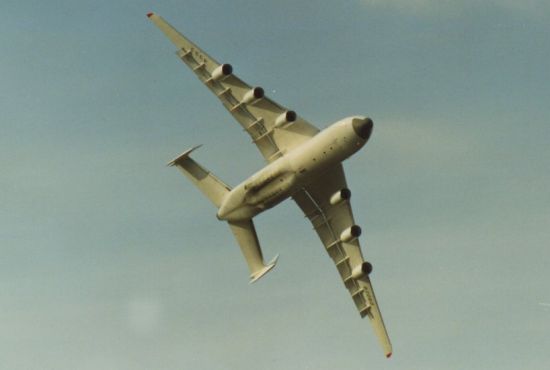
The An-225 is quoted as having a maximum takeoff weight of over 1.3 million pounds (600,000 kg). The FAI gives credit for a slightly lower weight of 1.12 million pounds (508,200 kg), the record set by an An-225 in 1989 for the largest mass ever lifted by an airplane to an altitude of 6,500 ft (2,000 m). The An-225 was originally built to ferry the Soviet Buran space shuttle but it is now used to transport various outsize cargos. Only one example was ever completed, and it is currently available for charter flights. The An-225 is a cargo transport only and has never been used as an airliner.
If we continue to measure by maximum takeoff weight, the next largest plane in the world would be either the related An-124 transport or the Boeing 747 airliner. Both aircraft are quoted with a maximum weight around 900,000 lb (405,000 kg). The An-124 was also built by the Soviet Union as a large cargo plane for both military and civil use. The basic design was later enlarged and adapted to produce the An-225.
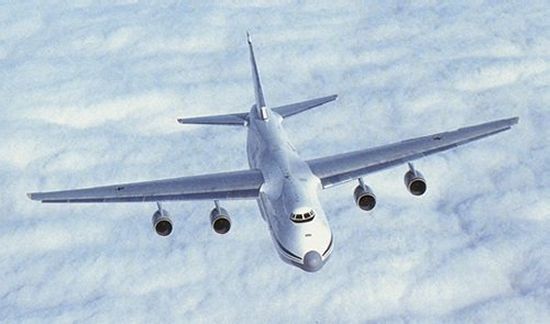
Over 50 examples of the An-124 were ultimately built, and many are now operated on charter flights through commercial firms. The American EP-3 reconnaissance plane that was forced to land after colliding with a Chinese fighter was actually transported back to the US aboard an An-124 chartered by the American government.

The Boeing 747, meanwhile, is currently the world's largest commercial airliner and typically carries about 400 passengers on intercontinental flights. The 747 will not retain its title for long, however, since the new Airbus A380 will carry over 550 passengers and have a takeoff weight over 1.23 million pounds (560,000 kg).
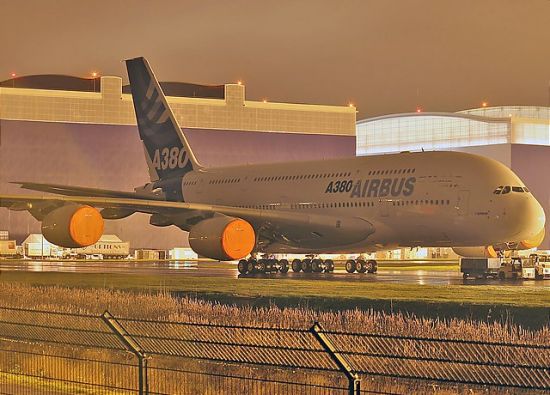
Once it enters service, the A380 will become the world's largest airliner and at least the second largest plane. Additional stretched models are also planned, and one of these will almost surely supersede the An-225 to take the official title as world's largest plane.
Your question also mentions two other classic aircraft that were certainly enormous by any measure. Unfortunately, both proved to be disastrous follies that were great embarrassments to their proponents. The Spruce Goose, officially known as the Hughes H-4 Hercules, was the brainchild of flamboyant billionaire Howard Hughes. The aircraft had originally been ordered by the US government during World War II as a giant cargo plane ferrying up to 750 armed troops or two 30-ton tanks. As the war concluded, Hughes believed he could adapt the massive plane to revolutionize long-distance transportation in the fledgling airline and air cargo industires. His creation was the world's largest plane at the time and is still the largest flying boat ever built with a maximum takeoff weight of 400,000 lb (180,000 kg). The enormous craft also holds records for the largest wingspan at 319 ft 11 in (97.5 m), tallest airplane at 79 ft 3 3/8 in (24.2 m), and the largest aircraft ever made from wood.

After pouring $7 million of his own money and another $18 million of government funds into the behemoth, Hughes only succeeded in making a single mile-long flight in 1947. The record-setting plane never flew again and is today a tourist attraction at the Evergreen Aviation Museum in Oregon.
Like the Spruce Goose, the Bristol Brabazon was another a government-sponsored effort intended to advance the state of the art in long-distance travel. The Brabazon was funded by the UK during the 1940s to develop a large airliner capable of non-stop flights between London and New York. Though smaller than the Spruce Goose, the Brabazon would have easily been the largest airliner of the day with a takeoff weight of 250,000 lb (115,000 kg) and a wingspan of 230 ft (70 m).

If successful, the Brabazon offered the opportunity to challenge American manufacturers for dominance in the commercial aviation market. Unfortunately, the ambitious design failed to receive government certification following the discovery of fatigue cracks in the propeller mountings. While the problem was certainly correctable, the UK decided to cancel further funding in the early 1950s even though £3 million had already been invested. Only one prototype had been built, and it was broken up for scrap in late 1953 after flying only 400 hours. An improved prototype with structural enhancements and turboprop engines was also under construction, but it too was scrapped after the project was cancelled.
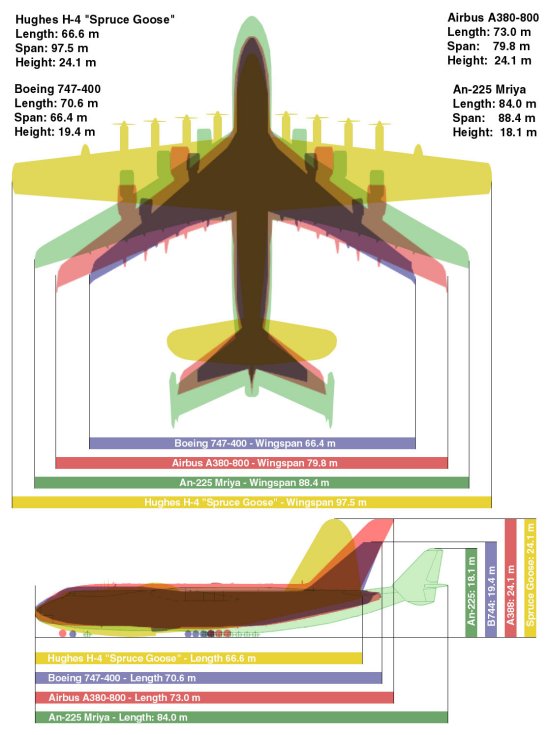
In summary, aircraft sizes are typically compared by weight rather than length or wingspan. The largest plane in
the world at the current time is therefore the An-225, though the A380 will likely overtake it in the near future.
The largest wingspan, however, still belongs to the Spruce Goose at nearly 320 feet. By this measure, the An-225
would be a distant second place at 290 ft, and the A380 falls short at 262 ft.
- answer by Molly Swanson, 8 August 2004
Additional Rankings:
Since this article was posted, we have received several messages from readers who believe the C-5 Galaxy transport operated by the US Air Force ranks second or third place and should be included. The C-5 was the world's largest plane when it was introduced in the late 1960s, but it has since been overtaken by the jet-powered aircraft discussed above.
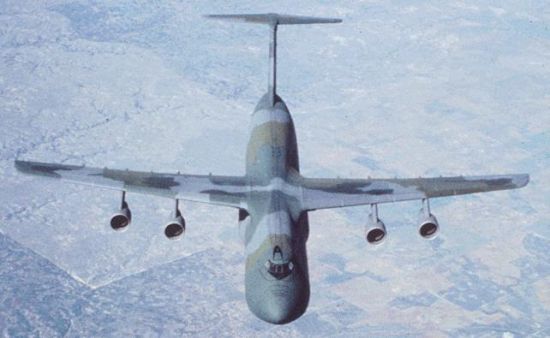
The C-5 remained the world's largest plane until the introduction of the An-124, and the C-5 has since been surpassed by the An-225, enlarged models of the 747, and the new A380 as well. The current ranking of the world's largest aircraft by maximum takeoff weight (MTOW) is shown in the following table.
| Rank | Aircraft | MTOW [lb] | Notes |
|---|---|---|---|
| 1. | An-225 Mriya | 1,300,000 | - |
| 2. | Airbus A380 | 1,230,000 | - |
| 3. | Boeing 747-400ER | 910,000 | the 747-8 under development will reach 960,000 lb |
| 4. | An-124 Ruslan | 892,870 | - |
| 5. | C-5 Galaxy | 840,000 | wartime only, peacetime TOW is limited to 769,000 lb |
| 6. | Airbus A340-600 HGW | 837,755 | high-gross weight variant |
| 7. | Boeing 777-300ER | 775,000 | highest available weight, loading restrictions apply |
With a wingspan of 223 ft, the C-5 currently ranks sixth after the Spruce Goose (320 ft), An-225 (290 ft), A380
(262 ft), An-124 (240 ft), and a tie between the Brabazon and B-36
(230 ft). The C-5 has a larger span than the 747-400 (211 ft) but will soon be narrowly beaten by the new 747-8
variant with a wingspan of nearly 225 ft.
- answer by Greg Alexander, 11 November 2005
Related Topics:
Read More Articles:


|
Aircraft | Design | Ask Us | Shop | Search |

|
|
| About Us | Contact Us | Copyright © 1997- | |||
|
|
|||